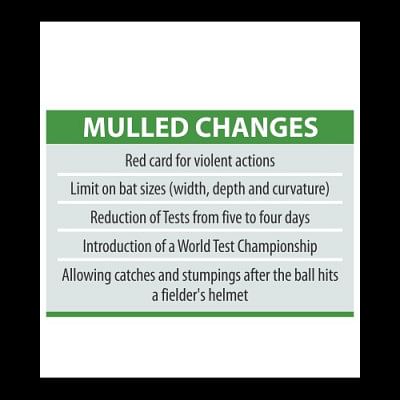Red cards in cricket!

Cricket, like football and hockey, may see introduction of red cards as punishment for violent acts on the field.
This was one of the recommendations made by the guardian of the game's laws, Marylebone Cricket Club (MCC), at its two-day meeting which ended in Mumbai yesterday.
The MCC's World Cricket Committee, headed by former England captain Mike Brearley, also recommended limiting the size of a bat's edges and depth in a bid to bring about a balance between bat and ball.
"There was a survey done of the umpires and 40 percent said they are considering giving up the game or giving up umpiring because of verbal abuse," Brearley said. "Anecdotal evidence from people who are familiar with leagues in parts of England say that the behaviour has got worse.
"The umpires have to be respected and given the best possible chance and I think cricket is the only game in which there isn't this possibility of an in-match punishment or deterrent," he added.
According to the suggestion, umpires will be given the power to eject a player from a game for serious disciplinary breaches such threatening an umpire, physically assaulting another player, umpire, official or spectator or for any other act of violence on the field of play.
The committee also deliberated on ball-tampering laws, but felt that they should remain unchanged, and was split vertically on the possibility of reducing Test cricket from a five-day affair to a four-day one.
Other recommendations included calling on the International Cricket Council (ICC) to continue to work towards introducing a World Test Championship and presenting the case for cricket at the Olympic Games while also changing the law on the ball striking a fielder's helmet.
All these recommendations will be sent to the main MCC Committee and, if approved, they will be implemented in the new code of the Laws of Cricket which will be introduced on October 1, 2017.
On the suggestion to reduce the bat size, Ponting said that 60 per cent of the world's professional players supported the decision to limit them to 40 mm on edges and 67 mm for depths, including 7 mm for curvature.
"We want to limit the edges to 38-42 mm. Some of the players have edges in excess of 50mm. We are happy with what we have come up which will restore the balance between the bat and the ball. We have seen top-edges and leading edges going for sixes. Even with the limit in bat size big hitters can still clear the ropes," said Ponting.
It was announced that the ball tampering law, which recently made headlines when South Africa captain Faf du Plessis was caught on camera using a mint in his mouth to help polish the ball during the series in Australia, will remain the same.
"Don't be caught," was the advice given by both Brearley and Ramiz Raja.
The change in the law regarding the ball striking a fielder's helmet says that catches and stumpings will be permitted after the ball has struck a fielder's helmet.
At present catches and stumpings may be taken off a wicket keeper's pads, the use of which is optional, and so it seems unfair that they should not be permitted after hitting a helmet, the wearing of which has become compulsory in the game, the committee said.
The change will include a ball becoming lodged or trapped in the grille of the fielder's helmet and will be treated in the same way as the ball getting trapped between the wicket keeper's pads or in a fielder's sweater or pocket, the committee stated.
The committee also discussed four-day Tests and day/night Tests and was split on the former suggestion.
About the need to try and include cricket in the Olympic Games, the committee said that Indian Cricket Board chief Anurag Thakur, who was asked about it separately, told them that he would keep an open mind.

 For all latest news, follow The Daily Star's Google News channel.
For all latest news, follow The Daily Star's Google News channel. 



Comments